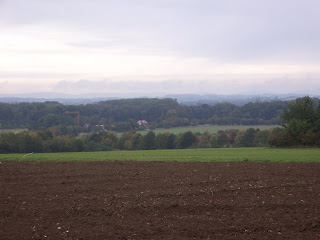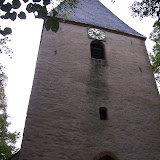2 October 2009
Jason says: We caught a train from Bielefeld to Herford and then a bus to Spenge and arrived at the town hall on a rainy day. Spenge is the local town where the Moellerings likely went to church, bought and sold crops and equipment and where some of them died.
Our first stop was the Lutheran Church of Sankt Martin, a church established in the 13th century and rebuilt in the 19th. Even if my family didn't go to the church, they certainly knew and saw it. As we approached, the minister, a woman named Claudia, greeted us and gave us a private tour of the now modernized interior and showed us a wood crafted alter screen from the 13th century - a relic my relatives probably saw and served as a link to their lives.
Lovely landscapes
From Spenge we walked to Hucker Kreuz, the village and farmland where the Moellerings lived and worked. What struck me as we approached was the beauty of the landscapes. For some reason I expected it to be a place that would somehow be plain...but it wasn't. There were lush fields and panoramic views across rolling hills. It was a good place to live and, I imagine, difficult to leave.
As we came into the village we spotted more connections to the past - a barn built in 1792 and then a windmill, built in 1860, the year Hermann and his brothers left for the U.S. Had they seen the windmill being built before they left? I wanted to think so.
We trekked on and approached the Moellering property. After a lot of research and planning, mainly due to Catherine and my aunt Janet's work, we were on the verge of seeing the very spot where my family lived for generations and where Hermann said goodbye as a teenager and made his way to a new, unknown land. Then we were there. An ordinary two story home sat where the original house must have been amongst a grassy, tree and bush-filled yard.
To anyone else, it would have been an unspectacular sight, but, to me, it was a Mecca, a place where the past and the present connected after 149 years. I felt like some sort of representative for all generations of our family and I was standing at the place that brought us all together. In a way, I had come home.
Catherine says: It was pretty interesting talking to Claudia, the church minister in Spenge. Once Jason had explained our reason for visiting the area, she immediately asked if Herman’s departure was in the 1840s or 1860s as this was the period of mass immigration from the area to the US. The failed 1848 revolution, local crop failures and financial incentives, amongst other things, had attracted huge numbers of immigrants to the US.
Having successfully navigated our way to Spenge using trains and the local bus service, we decided to walk the couple of miles into Hucker Kreuz. When Jason asked “Are we there yet?” for the third time, I encouraged him to reflect on how modest a journey it was compared the distance travelled by Herman and the rest of the Mollring crew. That’s an abridged version of the conversation.
The scenery was really lovely – all lush green fields and plump cattle. The houses and farms were all large and well cared for and it seemed like an area with a buoyant economy, unlike during Herman’s lifetime.
For more photos check out the following...
| Mollring Quest in Hucker Kreuz |





No comments:
Post a Comment